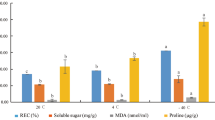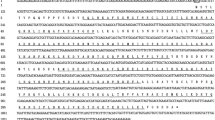Abstract
In plant species, the level of polyunsaturated fatty acids (PUFAs) is essential for cold acclimation. To test whether changes in PUFA levels can lead to the alteration of freezing tolerance in poplar trees, we up- and down-regulated a Populus tomentosa Δ-12 fatty acid desaturase gene (PtFAD2) in the hybrid poplar (P. alba × P. glandulosa) clone 84 K. Real-time PCR results demonstrated that compared to untransformed control lines, the transcriptional level of PtFAD2 increased by up to 90% in over-expressing poplar lines (line OE-1) and decreased in down-regulated RNAi lines by up to 64% (line DR-1). As a result, the content of linoleic (C18:2) and linolenic (C18:3) unsaturated fatty acids (FAs) in total FAs increased by 7.5 and 3.9%, respectively, in the OE-1 line and decreased by 14.4 and 5.4% in the DR-2 line when compared to non-transgenic lines. After freezing treatment at −4°C for 3 h without pre-cold acclimation, the survival rates of the PtFAD2-over-expressing cuttings were significantly higher (60% for OE-1) than those of non-transgenic plants (36.7%) and down-regulated lines (10% for DR-2). These results clearly demonstrate that the expression level of PUFAs substantially affected the freezing tolerance of hybrid poplar cuttings and could thus be utilized as an effective strategy to improve poplar anti-freezing traits through genetic engineering biotechnology.



Similar content being viewed by others
References
Beney L, Gervais P (2001) Influence of the fluidity of the membrane on the response of microorganisms to environmental stresses. Appl Microbiol Biotechnol 57:34–42
Browse J, Somerville C (1991) Glycerolipid synthesis: biochemistry and regulation. Annu Rev Plant Physiol Plant Mol Biol 42:467–506
Flint HI, Bouse BR, Beattie DJ (1967) Index of injury—a useful expression of freezing injury to plant tissues as determined by the electrolytic method. Can J Plant Sci 47:229–230
Gray GR, Chauvin LP, Sarhan F, Huner NPA (1997) Cold acclimation and freezing tolerance A complex interaction of light and temperature. Plant Physiol 114:467–474
Guy CL (1990) Cold acclimation and freezing tolerance: role of protein metabolism. Annu Rev Plant Physiol Plant Mol Biol 41:187–223
Ishizaki-Nishizawa O, Fujii T, Azuma M, Sekiguchi K, Murata N, Ohtani T, Toguri T (1996) Low-temperature resistance of higher plants is significantly enhanced by a nonspecific cyanobacterial desaturase. Nature Biotech 14:1003–1006
Khodakovskaya M, McAvoy R, Peters J, Wu H, Li Y (2006) Enhanced cold tolerance in transgenic tobacco expressing a chloroplast ω-3 fatty acid desaturase gene under the control of a cold-inducible promoter. Planta 223:1090–1100
Kodama H, Hamada T, Horiguchi G, Nishimura M, Iba K (1994) Genetic enhancement of cold tolerance by expression of a gene for chloroplast ω-3 fatty acid desaturase in transgenic tobacco. Plant Physiol 105:601–605
Los DA, Murata N (1998) Structure and expression of fatty acid desaturases. Biochim Biophys Acta 1394:3–15
Los DA, Murata N (2004) Membrane fluidity and its roles in the perception of environmental signals. Biochim Biophys Acta 1666:142–157
Martz F, Kiviniemi S, Palva TE, Sutinen ML (2006) Contribution of omega-3 fatty acid desaturase and 3-ketoacyl-ACP synthase II (KASII) genes in the modulation of glycerolipid fatty acid composition during cold acclimation in birch leaves. J Exp Bot 57:897–909
Mikami K, Murata N (2003) Membrane fluidity and the perception of environmental signals in cyanobacteria and plants. Prog Lipid Res 42:527–543
Miquel M, Browse J (1992) Arabidopsis mutants deficient in polyunsaturated fatty acid synthesis Biochemical and genetic characterization of a plant oleoyl-phosphatidylcholine desaturase. J Biol Chem 267:1502–1509
Murata N (1983) Species composition of phosphatidylglycerols from chilling-sensitive and chilling-resistant plants. Plant Cell Physiol 24:81–86
Murata N, Tasaka Y (1997) Glycerol-3-phosphate acyltransferase in plants. Biochim Biophys Acta 1348:10–16
Murata N, Sato N, Takahashi N, Hamazaki Y (1982) Composition and positional distributions of fatty acids in phospholipids from leaves of chilling-sensitive and chilling-resistant plants. Plant Cell Physiol 23:1071–1079
Murata N, Ishizaki-Nishizawa O, Higashi S, Hayashi H, Tasaka Y, Nishida I (1992) Genetically engineered alteration in the chilling sensitivity of plants. Nature 356:710–713
Nishida I, Murata N (1996) Chilling sensitivity in plants and cyanobacteria: the crucial contribution of membrane lipids. Annu Rev Plant Physiol Plant Mol Biol 47:541–568
Orlova IV, Serebriiskaya TS, Popov V, Merkulova N, Nosov AM, Trunova TI, Tsydendambaev VD, Los DA (2003) Transformation of tobacco with a gene for the thermophilic acyl-lipid desaturase enhances the chilling tolerance of plants. Plant Cell Physiol 44:447–450
Renaut J, Hoffmann L, Hausman JF (2005) Biochemical and physiological mechanisms related to cold acclimation and enhanced freezing tolerance in poplar plantlets. Physiol Planta 125:82–94
Roughan PG (1985) Phosphatidylglycerol and chilling sensitivity in plants. Plant Physiol 77:740–746
Roughan PG, Slack CR (1982) Cellular organization of glycerolipid metabolism. Annu Rev Plant Physiol 33:97–123
Sambrook J, Fritsch EF, Maniatis T (1989) Molecular cloning: a laboratory manual, 2nd edn. Cold Spring Harbor Laboratory Press, New York
Shen M, Huang M-R, Wang M-X, Hu Z-L, Bao H (1998) Studies on composition of molecular species of phosphatidylglycerol in relation to cold-resistance of poplar. Acta Bot Sin 40:349–355
Somerville C, Browse J (1996) Dissecting desaturation: plants prove advantageous. Trends Cell Biol 6:148–153
Sutinen ML, Palta JP, Reich PB (1992) Seasonal differences in the freezing stress resistance of needles of Pinus nigra and Pinus resinosa: evaluation of the electrolyte leakage method. Tree Physiol 11:241–254
Tang W, Tian YC (2003) Transgenic loblolly pine (Pinus taeda L.) plants expressing a modified-endotoxin gene of Bacillus thuringiensis with enhanced resistance to Dendrolimus punctatus Walker and Crypyothelea formosicola Staud. J Exp Bot 54:835–844
Thomashow MF (2001) So what’s new in the field of plant cold acclimation? Lots!. Plant Physiol 125:89–93
Wallis JG, Browse J (2002) Mutants of Arabidopsis reveal many roles for membrane lipids. Prog Lipid Res 41:254–278
Wang SY, Chen QJ, Wang WL, Wang XC, Lu MZ (2005) Salt tolerance conferred by over-expression of OsNHX1 gene in Poplar 84 K. Chin Sci Bull 50:224–228
Zhou Z, Zhang D, Lu M-Z (2007) Cloning and expression analysis of PtFAD2 gene encoding the endoplasmic reticulum fatty acid C18:1 desaturase in Populus tomentosa. Sci Silvae Sin 143:16–21
Acknowledgments
We thank Dr. Liu Qing of the CSIRO Plant Industry in Australia for critical review of this manuscript and for providing the pHurricane vector. This study was supported by grants from the High Tech Development Program (2006AA100109) and Introduction of Foreign Advanced Agricultural Science and Technology into China (No. 2006-4-C01).
Author information
Authors and Affiliations
Corresponding author
Additional information
Z. Zhou and M.-J. Wang have the same contribution to this paper.
Electronic supplementary material
Below is the link to the electronic supplementary material.
11248_2009_9349_MOESM1_ESM.tif
Supplementary Figure 1 Diagrammatic representation of the PtFAD2 up-regulated (A) and down-regulated (B) constructs. NPTII: neomycin phosphotransferase II; CaMV35S: Cauliflower mosaic virus 35S promoters; At FAD2 intron 1.2 kb: the 1.2-kb fragment of the second intron of the Arabidopsis thaliana AtFAD2 served as the spacer for the hairpin structure formation in pHurricane; NOS Pro and NOS Ter: Nopaline synthase promoter and terminator, respectively. (TIFF 1886 kb)
Rights and permissions
About this article
Cite this article
Zhou, Z., Wang, MJ., Zhao, ST. et al. Changes in freezing tolerance in hybrid poplar caused by up- and down-regulation of PtFAD2 gene expression. Transgenic Res 19, 647–654 (2010). https://doi.org/10.1007/s11248-009-9349-x
Received:
Accepted:
Published:
Issue Date:
DOI: https://doi.org/10.1007/s11248-009-9349-x




